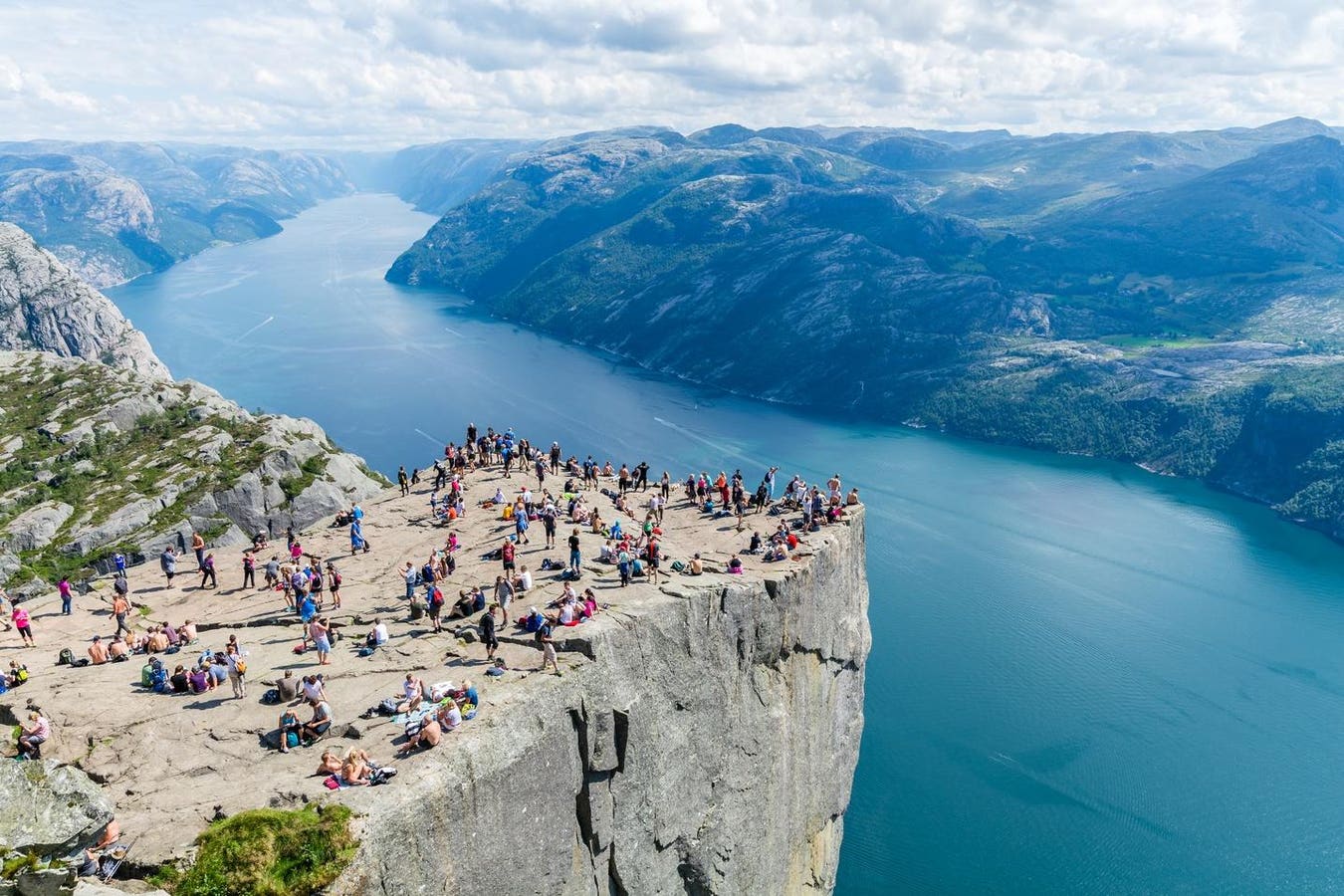More people than ever before are making the hike to Preikestolen, or Pulpit Rock, in Norway.
getty
Thanks to its beloved ‘right to roam’ policy, Norway’s famed hiking trails have long been accessible to anyone willing to make the trek.
From the iconic Preikestolen (Pulpit Rock) with a view along the Lysefjord to the steep ascent of Reinebringen in Lofoten, these routes have drawn adventurers from around the world.
However, as tourism continues to rise and overcrowding raises safety concerns, local authorities are considering imposing visitor caps or other measures on peak days.
Any such move could conflict with allemannsretten, Norway’s right to roam, which guarantees free access to nature. Given its deep roots in friluftsliv—the nation’s cherished outdoor lifestyle—imposing such restrictions would come at a significant cultural cost.
Why Restrictions Are Being Considered
Preikestolen, one of Norway’s most famous natural attractions, saw a record 380,000 visitors make the hike in 2024. If current trends continue, a projected 500,000 or more visitors may attempt the hike by 2030.
On the busiest days, up to 5,800 hikers make the five-mile roundtrip to the famous cliff, leading to congestion on narrow paths, long queues, and safety risks along the route and on the clifftop itself.
Similarly, Reinebringen, a steep hike in the Lofoten Islands, saw nearly 4,800 hikers in a single day last summer. The increasing foot traffic on its narrow staircase-style trail has made it difficult for emergency responders to assist in accidents or medical emergencies.
Parking is a major challenge in both locations. At Preikestolen, the main lot frequently reaches capacity during peak times, forcing closures and frustrating eager hikers. In the Lofoten Islands, illegal and unsafe parking has long been an issue, disrupting locals and obstructing emergency vehicles.
Faced with these challenges, local officials and trail managers are proposing legal changes to allow temporary visitor caps, limiting the number of hikers on high-traffic days.
A Clash With Norway’s Right To Roam
Norway’s allemannsretten, or the right to roam, is a fundamental principle that allows unrestricted access to forests, mountains, and coastlines, regardless of land ownership.
Hikers enjoying the view of the Lofoten Islands in Northern Norway.
getty
Enshrined in the Outdoor Recreation Act of 1957, this law ensures that both locals and visitors can freely explore nature, provided they do so responsibly.
Under the current legal framework, only the police can restrict access in extraordinary circumstances. This means that even the busiest trails cannot legally turn away hikers, no matter how crowded they get.
Trail managers argue that times have changed, and with the surge of international tourism, Norway must adapt.
Helge Kjellevold, director of the Preikestolen Foundation, told NRK that common sense solutions are needed given that allemannsretten was established in a time before the large number of annual visitors.
Possible Solutions Beyond Visitor Caps
Climate and environment minister Andreas Bjelland Eriksen confirmed that Norway’s government has no plans to amend the right to roam, something he called “one of the greatest things we have in Norway.”
While outright restrictions on hiking would be controversial, alternative measures are being explored, something the minister supports.
Some municipalities are looking to limit parking availability to control visitor numbers. Others are considering shuttle bus systems that would encourage tourists to use public transport instead of driving directly to trailheads.
There is also a push to spread out visitors by promoting early morning or late-evening hikes and encouraging travel outside peak summer months.
For example, guide-led winter hikes to Preikestolen are now being promoted, and the official Preikestolen website also recommends the use of a guide in winter months.
The Norwegian Trekking Association (DNT) has emphasized that restrictions should be a last resort, advocating instead for better trail management and education.
Authorities are also working to develop and advertise lesser-known hiking routes to distribute visitors more evenly across different locations.
Tourists Still Have Right To Roam, For Now
For now, hikers can still enjoy unrestricted access to Norway’s iconic trails, but visitors should prepare for potential crowd management measures, such as timed entry slots, shuttle services, or limited parking at Norway’s most famous hiking trails.
Planning a trip? Consider hiking during the shoulder seasons of spring and autumn to avoid peak crowds, explore alternative trails beyond well-known spots, and check for local regulations in advance to understand any potential restrictions to the right to roam.
MORE FROM FORBESForbesA Guide To Åndalsnes, Norway For Cruise Ship VisitorsBy David NikelForbesWhat’s New About Norway Travel In 2025By David NikelForbesWhy Norway Is Now A Year-Round Cruise Travel DestinationBy David Nikel
